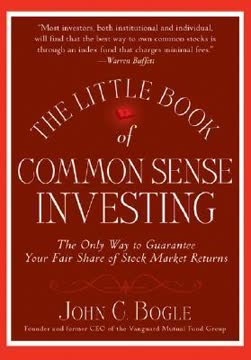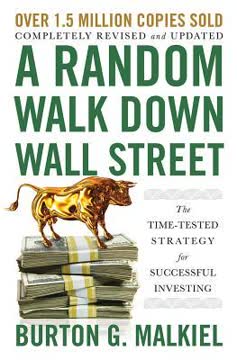Key Takeaways
1. Spend less than you earn, invest the surplus, and avoid debt
"Do simply this and you'll wind up rich. Not just in money."
Financial independence starts with discipline. The foundation of building wealth is straightforward: live below your means and redirect the excess into investments. This approach not only grows your net worth but also cultivates a mindset of financial responsibility.
Debt is a wealth destroyer. Avoid debt like the plague, especially high-interest consumer debt. When you carry debt, you're essentially working for someone else's benefit. Every dollar spent on interest is a dollar that could have been invested and grown over time.
- Save aggressively: Aim for 50% or more of your income
- Invest early and often: Take advantage of compound interest
- Eliminate and avoid debt: Pay off high-interest debt first
- Live frugally: Focus on experiences rather than possessions
2. Harness the power of index funds for long-term wealth building
"The harsh truth is, I can't pick winning stocks and you can't either."
Simplicity beats complexity in investing. Index funds, particularly low-cost total stock market index funds like VTSAX, offer the most effective way for individual investors to build wealth over time. They provide broad diversification, low costs, and consistently outperform actively managed funds.
Time in the market beats timing the market. Instead of trying to pick individual stocks or time market movements, focus on consistently investing in a broad-based index fund. This approach harnesses the overall growth of the economy and reduces the risk of underperformance due to poor stock selection or market timing.
- Choose a low-cost total stock market index fund (e.g., VTSAX)
- Invest regularly, regardless of market conditions
- Ignore short-term market fluctuations
- Let compound interest work its magic over decades
3. Understand market volatility and stay the course
"The market always goes up. Always."
Embrace market fluctuations. The stock market's long-term trend is upward, but the journey is rarely smooth. Understanding that volatility is normal and expected can help you maintain your investment strategy during turbulent times.
Psychological fortitude is crucial. The biggest enemy to successful investing is often our own emotions. Fear and greed can lead to poor decision-making, such as selling during market downturns or chasing hot investments. Developing the mental toughness to stick to your investment plan through ups and downs is essential for long-term success.
- Expect and accept market crashes as part of the process
- View market downturns as buying opportunities
- Focus on long-term trends rather than short-term fluctuations
- Educate yourself to build confidence in your investment strategy
4. Embrace simplicity in your investment strategy
"Complex investments exist only to profit those who create and sell them."
Simplicity is powerful. A straightforward investment strategy using just one or two index funds can outperform complex portfolios managed by professionals. This approach not only yields better results but also requires less time and effort to maintain.
Avoid the noise of financial media. The constant stream of market predictions, hot stock tips, and complex investment strategies is largely noise that can lead you astray. Instead, focus on the fundamentals of low-cost, broadly diversified investing and tune out the rest.
- Use a simple portfolio of 1-2 index funds (e.g., VTSAX and VBTLX)
- Avoid actively managed funds and their high fees
- Ignore market predictions and stock picking advice
- Spend your time and energy on other aspects of life
5. Maximize tax-advantaged accounts for optimal growth
"None of these tax-advantaged buckets eliminates your tax obligation. They only defer it."
Leverage tax-advantaged accounts. Utilize accounts like 401(k)s, IRAs, and Roth IRAs to maximize your investment growth. These accounts offer tax benefits that can significantly boost your long-term returns.
Understand the tax implications. Each type of account has different tax treatments and rules. Knowing how and when to use each type can help you optimize your tax situation both during your working years and in retirement.
- Prioritize contributions: 401(k) to employer match, then IRA/Roth IRA, then max out 401(k)
- Consider tax diversification: Mix of pre-tax and Roth accounts
- Understand withdrawal rules and required minimum distributions (RMDs)
- Use HSAs as a powerful triple-tax-advantaged investment vehicle
6. Plan for retirement with the 4% rule and flexibility
"4% is only a guide. Sensible flexibility is what provides security."
The 4% rule as a starting point. This guideline suggests that you can withdraw 4% of your portfolio value annually in retirement with a high probability of not running out of money. It provides a useful benchmark for retirement planning.
Remain flexible in retirement. While the 4% rule is a good starting point, it's important to adjust your withdrawal rate based on market conditions and personal circumstances. Being willing to cut back during market downturns can significantly improve the longevity of your portfolio.
- Use the 4% rule to estimate your retirement portfolio needs
- Be prepared to adjust spending in response to market conditions
- Consider part-time work or side hustles in retirement for added flexibility
- Regularly reassess your withdrawal strategy
7. Beware of financial predators and stay vigilant
"Everybody can be conned."
Financial literacy is your best defense. Understanding basic investment principles and being aware of common scams can help protect you from financial predators. Remember that if something sounds too good to be true, it probably is.
Be wary of conflicts of interest. Many financial advisors and investment products have inherent conflicts of interest that may not align with your best interests. Understanding these conflicts and seeking out fiduciary advisors when necessary can help protect your wealth.
- Educate yourself on common investment scams and tactics
- Be skeptical of investment opportunities that promise high returns with low risk
- Understand the fee structures of any investment products or advisors
- Trust your instincts and don't be pressured into quick decisions
8. Social Security: Understand its future and plan accordingly
"If you are 55 or older you'll collect every dime."
Social Security's future is complex. While the system faces challenges, it's unlikely to disappear entirely. However, younger generations may see reduced benefits or increased retirement ages.
Optimize your benefits. Understanding how Social Security works and strategizing when to claim benefits can significantly impact your retirement income. Consider factors like your health, family longevity, and spousal benefits when deciding when to start claiming.
- Don't rely solely on Social Security for retirement income
- Consider delaying benefits to increase monthly payments
- Understand how working in retirement affects your benefits
- Stay informed about potential changes to the system
Last updated:
FAQ
What's "The Simple Path to Wealth" about?
- Financial Independence Focus: "The Simple Path to Wealth" by J.L. Collins is a guide to achieving financial independence and living a rich, free life. It emphasizes the importance of mastering money to gain freedom.
- Investment Strategy: The book advocates for a simple investment strategy using low-cost index funds, particularly those offered by Vanguard, to build wealth over time.
- Personal Finance Advice: It provides practical advice on saving, investing, and avoiding debt, aiming to simplify the often complex world of personal finance.
- Life Philosophy: Beyond finances, the book encourages readers to live life on their own terms, using financial independence as a tool to explore personal passions and interests.
Why should I read "The Simple Path to Wealth"?
- Simplified Investing: The book demystifies investing, making it accessible to those who may find the topic intimidating or complex.
- Proven Strategies: J.L. Collins shares strategies that have worked for him, backed by historical data and personal experience, offering a reliable path to financial security.
- Empowerment: It empowers readers to take control of their financial future, emphasizing that anyone can achieve financial independence with the right approach.
- Life Lessons: The book is not just about money; it also offers insights into living a fulfilling life, free from financial stress.
What are the key takeaways of "The Simple Path to Wealth"?
- Index Funds: Investing in low-cost index funds, like Vanguard's Total Stock Market Index Fund (VTSAX), is a core strategy for building wealth.
- Avoid Debt: Debt is a major obstacle to financial independence; the book advises avoiding it whenever possible.
- F-You Money: Having enough savings to say "no" to undesirable situations is crucial for personal freedom and security.
- Simplicity and Patience: Keeping investments simple and being patient with market fluctuations are essential for long-term success.
How does J.L. Collins suggest handling market volatility?
- Expect Volatility: Collins emphasizes that market volatility is normal and should be expected as part of the investment journey.
- Stay the Course: He advises against trying to time the market, suggesting that investors should remain invested and not panic during downturns.
- Long-Term Perspective: The book encourages a long-term view, highlighting that the market has historically always gone up over extended periods.
- Buying Opportunities: Market drops are seen as opportunities to buy more shares at lower prices, ultimately benefiting long-term investors.
What is the "4% Rule" mentioned in "The Simple Path to Wealth"?
- Withdrawal Rate: The 4% Rule is a guideline for how much you can withdraw from your retirement savings annually without running out of money.
- Trinity Study: Based on the Trinity Study, it suggests that a 4% withdrawal rate, adjusted for inflation, is sustainable for a 30-year retirement period.
- Flexibility Required: While generally reliable, the rule requires flexibility; in years of poor market performance, spending may need to be adjusted.
- Portfolio Composition: The rule assumes a balanced portfolio, typically 50% stocks and 50% bonds, to manage risk and growth.
What are the best quotes from "The Simple Path to Wealth" and what do they mean?
- "Spend less than you earn—invest the surplus—avoid debt." This quote encapsulates the core financial philosophy of the book, emphasizing the importance of saving and investing wisely.
- "The market always goes up." Collins reassures readers that despite short-term volatility, the stock market has historically increased in value over the long term.
- "F-You Money is critical." This highlights the importance of having enough savings to maintain independence and make choices aligned with personal values.
- "Simplicity is the keynote of all true elegance." Reflecting the book's approach, this quote underscores the value of keeping financial strategies straightforward and effective.
How does J.L. Collins recommend structuring a portfolio?
- Core Holdings: Collins recommends a simple portfolio primarily composed of Vanguard's Total Stock Market Index Fund (VTSAX) for stocks and Total Bond Market Index Fund (VBTLX) for bonds.
- Asset Allocation: The allocation between stocks and bonds should reflect the investor's stage in life, risk tolerance, and financial goals.
- Tax Efficiency: He suggests holding tax-efficient investments in taxable accounts and tax-inefficient ones, like bonds, in tax-advantaged accounts.
- Rebalancing: Periodically rebalancing the portfolio to maintain the desired asset allocation is advised, though not overly frequently.
What is "F-You Money" and why is it important according to "The Simple Path to Wealth"?
- Definition: "F-You Money" is a term used to describe having enough savings to walk away from undesirable situations without financial worry.
- Freedom and Security: It provides the freedom to make life choices based on personal values rather than financial necessity.
- Negotiation Power: Having F-You Money gives individuals leverage in negotiations, whether in personal or professional contexts.
- Peace of Mind: It offers peace of mind, knowing that financial stability is not dependent on any single job or income source.
How does "The Simple Path to Wealth" address debt management?
- Avoidance: The book strongly advises avoiding debt whenever possible, as it is a significant barrier to financial independence.
- Debt Elimination: For those already in debt, Collins suggests prioritizing its elimination, especially high-interest debt, to free up resources for investing.
- Psychological Impact: Debt is likened to being covered in leeches, emphasizing its draining effect on financial and emotional well-being.
- Financial Freedom: Eliminating debt is a crucial step toward achieving financial freedom and the ability to invest more aggressively.
What is J.L. Collins' view on investment advisors in "The Simple Path to Wealth"?
- Skepticism: Collins is skeptical of investment advisors, citing conflicts of interest and high fees that can erode investment returns.
- Self-Management: He advocates for self-management of investments, emphasizing that individuals can achieve better results with simple strategies.
- Cost Concerns: The book highlights the significant cost of advisor fees over time, which can substantially reduce the growth of a portfolio.
- Education and Empowerment: By educating themselves, investors can make informed decisions and avoid the pitfalls of relying on potentially biased advisors.
How does "The Simple Path to Wealth" suggest handling retirement accounts like 401(k)s and IRAs?
- Maximize Contributions: Collins advises maximizing contributions to tax-advantaged accounts like 401(k)s and IRAs to benefit from tax deferral.
- Employer Match: Taking full advantage of any employer match in a 401(k) is recommended, as it is essentially free money.
- Roth vs. Traditional: The book discusses the benefits of both Roth and Traditional IRAs, suggesting Roth IRAs for those in lower tax brackets.
- Rollovers: When changing jobs, rolling over 401(k) funds into an IRA is suggested to maintain control and potentially reduce fees.
What is the role of bonds in the investment strategy outlined in "The Simple Path to Wealth"?
- Stability and Income: Bonds provide stability and income, helping to smooth out the volatility of stocks in a portfolio.
- Deflation Hedge: They serve as a hedge against deflation, offering a counterbalance to the inflation protection provided by stocks.
- Risk Management: As investors approach retirement, increasing bond allocation can reduce risk and preserve capital.
- VBTLX Recommendation: Collins recommends Vanguard's Total Bond Market Index Fund (VBTLX) for its broad diversification and low cost.
Review Summary
The Simple Path to Wealth receives high praise for its straightforward approach to financial independence. Readers appreciate Collins' clear advice on avoiding debt, saving aggressively, and investing in low-cost index funds. The book is lauded for its simplicity and effectiveness, particularly for those new to investing. Some criticisms include its US-centric focus and lack of guidance for older investors. Many consider it a must-read for anyone seeking financial literacy, though its applicability may vary for non-US readers.
Similar Books










Download PDF
Download EPUB
.epub digital book format is ideal for reading ebooks on phones, tablets, and e-readers.




